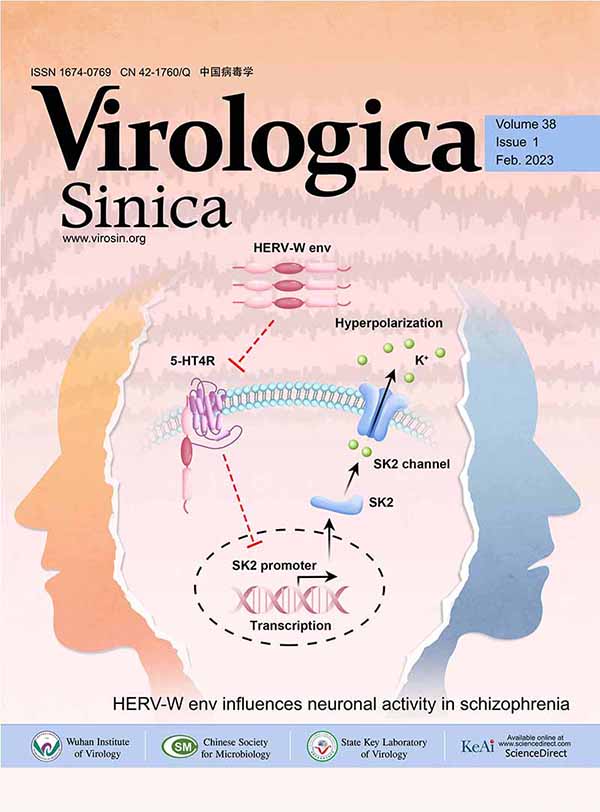Etiological Study of Respiratory Tract Infections in Children Using Multi-analyte Suspension Array Technology[J]. Virologica Sinica, 2005, 20(6): 586-589.
Citation:
.
Etiological Study of Respiratory Tract Infections in Children Using Multi-analyte Suspension Array Technology .VIROLOGICA SINICA, 2005, 20(6)
: 586-589.
-
摘要
利用多靶点液相芯片(Multi-Analyte Suspension Array,MASA)技术对引起儿童呼吸道感染(respiratory tract infections,RTI)的病原,包括人类呼吸道合胞病毒A型和B型(Human respiratory syncytial virus A and B, RSVA、RSVB)、严重急性呼吸综合征冠状病毒(Severe acute respiratory syndrome coronavirus,SARS-CoV)、流行 性感冒病毒A型和B型(Influenza A virus and Influenza B virus,INFa,INFb)、副流感病毒1型和3型(Parain- fluenza virus 1 and 3,PIV1,PIV3)、衣原体(C.pneumoniae,CPN)和支原体(M.pneumoniae,MPN)进行了病原学 研究。我们采集并分析了140例患典型呼吸道感染症状儿童的咽拭子,发现在这些标本中至少被前述的一种病 原感染的标本有95例,阳性率为67.86%。结果显示这些标本中上述病原感染的情况分别为:RSVB感染的患儿 占35.71%、PIV3感染的占4.29%、INFa感染的占28.57%、INFb感染的占2.14%、MPN感染的占3.57%、CPN 感染的占17.86%,被两种以上病原混合感染的患儿有17.14%。这些标本中都没有检测到RSVA、PIV1和SARS- CoV病原的感染。RSVB病原的感染率在3岁以下的患儿中明显高于3岁以上的患儿,而INFa的感染情况则相 反;在上呼吸道感染患儿中检测到INFa病原感染的比例明显高于下呼吸道感染,而RSVB病原感染的情况相反。 此外,我们发现在2005年3月-5月中造成武汉地区儿童呼吸道感染的主要病原是以RSVB、INFa、CPN为主,而 RSVB感染则又是引起儿童下呼吸道感染和引起低龄儿童呼吸道感染的重要病原。
关键词:
-
液相芯片
-
,
呼吸道感染
-
,
病原
-
,
儿童
Etiological Study of Respiratory Tract Infections in Children Using Multi-analyte Suspension Array Technology
-
1,2
,
-
1
,
-
3
,
-
3
,
-
3
,
-
1
,
-
2*
,
-
1*
-
Abstract
The etiology of respiratory tract infection (RTI) pathogens, e. g. Human respiratory syncytial virus A and B (RSVA, RSVB), Severe acute respiratory syndrome coronavirus (SARS-Cov), Influenza A virus and Influenza B virus (INFa, INFb), Influenza A virPara-influenza virus 1 and 3 (PIV1、PIV3), M. pneumoniae (MPN) and C. pneumoniae (CPN), were investigated using Multi-Analyte Suspension Array (MASA) technology. Samples were collected from throat swabs of 140 children symptomatic of typical respiratory tract infection. Ninety-five samples (67. 85%) were positive for at least one of the above pathogens. The infection rate was 35. 71% for RSVB, 4. 29% for PIV3, 28. 57% for INFa, 2. 14% for INFb, 3. 57% for MPN and 17. 86% for CPN. The ratio of mixed infection was 17. 14%. RSVA、PIV1、SARS were not detected. The infection rate of RSVB in children younger than 3 years was higher than that for children older than 3 years, while, IFNa in children younger than 3 years was lower than that of children older than 3 years. The
-

-
References
-
Proportional views

-
-














 DownLoad:
DownLoad: